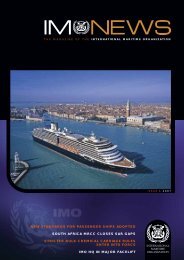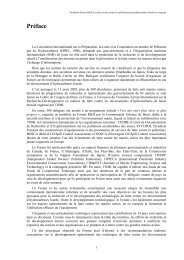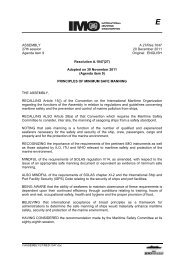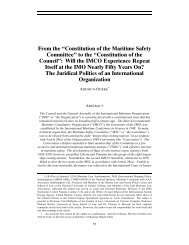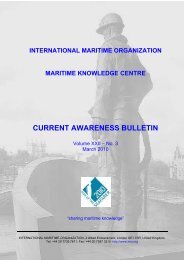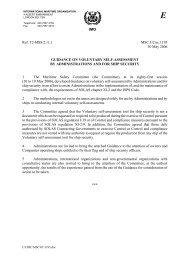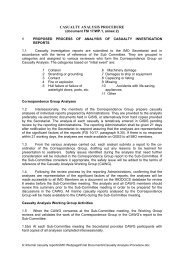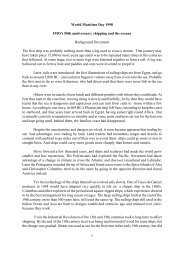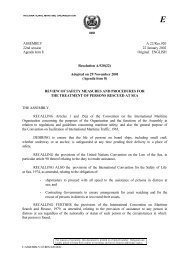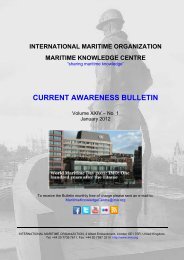Supplement: FSS Code - IMO
Supplement: FSS Code - IMO
Supplement: FSS Code - IMO
You also want an ePaper? Increase the reach of your titles
YUMPU automatically turns print PDFs into web optimized ePapers that Google loves.
.4 no section will pass through a space twice. When this is not practical<br />
(e.g., for large public spaces), the part of the section which by necessity<br />
passes through the space for a second time shall be installed at the<br />
maximum possible distance from the other parts of the section.<br />
2.1.7 In passenger ships, the fixed fire detection and fire alarm system shall be capable of<br />
remotely and individually identifying each detector and manually operated call point. Fire<br />
detectors fitted in passenger ship cabins, when activated, shall also be capable of emitting,<br />
or cause to be emitted, an audible alarm within the space where they are located. In cargo<br />
ships and on passenger ship cabin balconies the fixed fire detection and fire alarm system<br />
shall, as a minimum, have section identification capability.<br />
2.2 Sources of power supply<br />
2.2.1 There shall be not less than two sources of power supply for the electrical<br />
equipment used in the operation of the fixed fire detection and fire alarm system, one of<br />
which shall be an emergency source of power. The supply shall be provided by separate<br />
feeders reserved solely for that purpose. Such feeders shall run to an automatic changeover<br />
switch situated in or adjacent to the control panel for the fire detection system. The main<br />
(respective emergency) feeder shall run from the main (respective emergency) switchboard<br />
to the changeover switch without passing through any other distributing switchboard.<br />
2.2.2 There shall be sufficient power to permit the continued operation of the system with<br />
all detectors activated, but not more than 100 if the total exceeds this figure.<br />
2.2.3 The emergency source of power specified in paragraph 2.2.1 above shall be<br />
sufficient to maintain the operation of the fire detection and fire alarm system for the periods<br />
required under regulations II-1/42 and 43 of the Convention, and at the end of that period,<br />
shall be capable of operating all connected visual and audible fire alarm signals for a period<br />
of at least 30 min.<br />
2.3 Component requirements<br />
2.3.1 Detectors<br />
2.3.1.1 Detectors shall be operated by heat, smoke or other products of combustion, flame,<br />
or any combination of these factors. Detectors operated by other factors indicative of<br />
incipient fires may be considered by the Administration provided that they are no less<br />
sensitive than such detectors.<br />
2.3.1.2 Smoke detectors required in all stairways, corridors and escape routes within<br />
accommodation spaces shall be certified to operate before the smoke density exceeds<br />
12.5% obscuration per metre, but not until the smoke density exceeds 2% obscuration per<br />
metre, when tested according to standards EN 54:2001 and IEC 60092-505:2001. Alternative<br />
testing standards may be used as determined by the Administration. Smoke detectors to be<br />
installed in other spaces shall operate within sensitivity limits to the satisfaction of the<br />
Administration having regard to the avoidance of detector insensitivity or oversensitivity.<br />
2.3.1.3 Heat detectors shall be certified to operate before the temperature exceeds 78ºC<br />
but not until the temperature exceeds 54ºC, when the temperature is raised to those limits at<br />
a rate less than 1ºC per min, when tested according to standards EN 54:2001 and<br />
IEC 60092-505:2001. Alternative testing standards may be used as determined by the<br />
Administration. At higher rates of temperature rise, the heat detector shall operate within<br />
temperature limits to the satisfaction of the Administration having regard to the avoidance of<br />
detector insensitivity or oversensitivity.<br />
2.3.1.4 The operation temperature of heat detectors in drying rooms and similar spaces of a<br />
normal high ambient temperature may be up to 130ºC, and up to 140ºC in saunas.<br />
<strong>Supplement</strong> to the <strong>FSS</strong> <strong>Code</strong> (2007 Edition) 13



